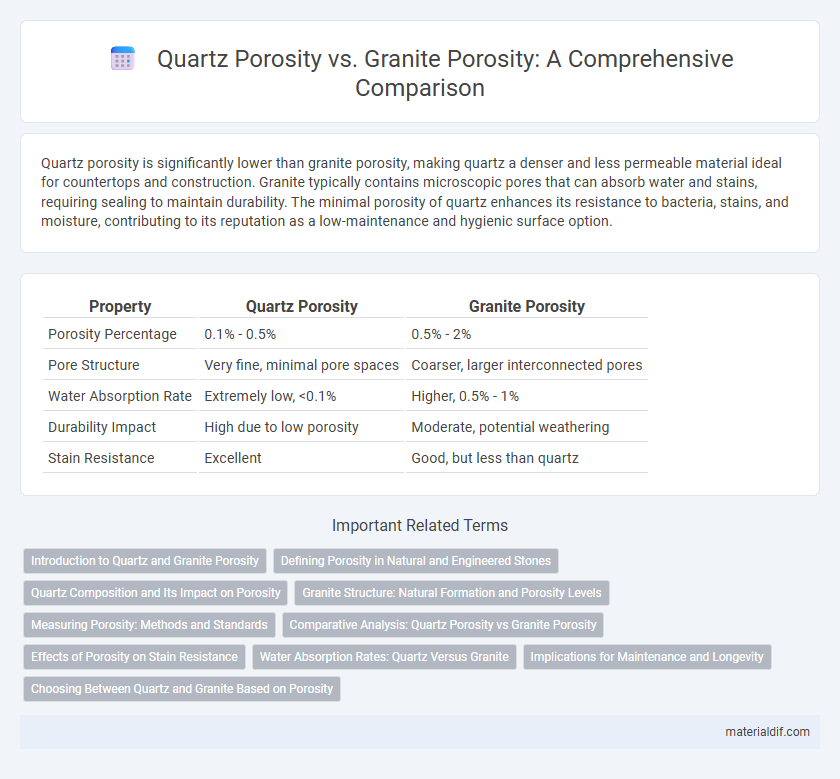Quartz porosity is significantly lower than granite porosity, making quartz a denser and less permeable material ideal for countertops and construction. Granite typically contains microscopic pores that can absorb water and stains, requiring sealing to maintain durability. The minimal porosity of quartz enhances its resistance to bacteria, stains, and moisture, contributing to its reputation as a low-maintenance and hygienic surface option.
Table of Comparison
| Property | Quartz Porosity | Granite Porosity |
|---|---|---|
| Porosity Percentage | 0.1% - 0.5% | 0.5% - 2% |
| Pore Structure | Very fine, minimal pore spaces | Coarser, larger interconnected pores |
| Water Absorption Rate | Extremely low, <0.1% | Higher, 0.5% - 1% |
| Durability Impact | High due to low porosity | Moderate, potential weathering |
| Stain Resistance | Excellent | Good, but less than quartz |
Introduction to Quartz and Granite Porosity
Quartz exhibits low porosity due to its densely packed crystalline structure, typically ranging from 0.5% to 2%, which limits fluid storage and permeability. Granite, composed of quartz, feldspar, and mica, has slightly higher porosity values, generally between 1% and 5%, influenced by microfractures and mineral grain boundaries. Understanding these porosity differences is critical for applications in reservoir engineering, hydrogeology, and construction materials where fluid flow and storage capacity are essential.
Defining Porosity in Natural and Engineered Stones
Porosity in natural and engineered stones measures the volume of void spaces within the material, directly affecting water absorption and durability. Quartz typically exhibits very low porosity, often below 0.05%, making it highly resistant to stains and moisture penetration compared to granite, whose porosity ranges from 0.5% to over 2%. This difference arises because quartz is engineered with a dense composition of resin and mineral aggregates, while granite's natural crystalline structure contains more interconnected pores.
Quartz Composition and Its Impact on Porosity
Quartz, composed primarily of silicon dioxide (SiO2), exhibits low intrinsic porosity due to its tightly packed crystalline structure, which limits pore space. In contrast, granite, containing a mix of quartz, feldspar, and mica, has higher porosity influenced by mineral grain boundaries and fractures. The dominance of quartz in quartz-rich rocks results in reduced porosity and lower permeability compared to the more heterogeneous mineral composition of granite.
Granite Structure: Natural Formation and Porosity Levels
Granite's natural formation through the slow cooling of magma results in an interlocking crystalline structure, characterized by relatively low porosity levels typically ranging from 0.5% to 2%. This dense mineral matrix limits fluid permeability compared to quartz, which often exhibits higher porosity due to its sedimentary origins and more fragmented grain structure. Understanding granite's structural composition and minimal porosity is crucial for applications requiring durability and low permeability, such as construction and engineered stone surfaces.
Measuring Porosity: Methods and Standards
Quartz porosity is typically lower than granite porosity, with quartz averaging around 0.5-2% compared to granite's 1-5%. Measuring porosity involves techniques such as mercury intrusion porosimetry, helium pycnometry, and gas adsorption, each adhering to established standards like ASTM D4284 for mercury intrusion and ISO 24512 for gas adsorption. Accurate porosity measurement is critical for geological and industrial applications, ensuring reliable data on pore volume, connectivity, and permeability in quartz and granite samples.
Comparative Analysis: Quartz Porosity vs Granite Porosity
Quartz exhibits significantly lower porosity compared to granite, typically under 1%, due to its tightly packed crystalline structure that limits pore spaces. Granite porosity ranges from 1% to 5%, influenced by its heterogeneous mineral composition and the presence of microfractures that enhance permeability. This difference in porosity affects fluid retention and mechanical strength, making quartz more resistant to water absorption and weathering than granite in geological and construction applications.
Effects of Porosity on Stain Resistance
Quartz porosity typically ranges from 0.5% to 1%, while granite porosity averages between 0.5% and 5%, directly affecting stain resistance. Lower porosity in quartz results in minimal fluid absorption, enhancing its resistance to stains and bacterial growth compared to granite. Higher porosity in granite permits greater absorption of liquids, leading to increased vulnerability to staining and requiring regular sealing for protection.
Water Absorption Rates: Quartz Versus Granite
Quartz exhibits significantly lower porosity compared to granite, resulting in reduced water absorption rates that typically range below 0.1%. Granite's porosity can vary between 0.2% and 0.5%, making it more prone to water absorption and potential staining. The dense, non-porous surface of quartz enhances its durability and resistance to moisture-related damage relative to granite.
Implications for Maintenance and Longevity
Quartz porosity is significantly lower than granite porosity, resulting in enhanced resistance to moisture absorption and staining. This low porosity in quartz surfaces reduces the need for frequent sealing and extensive maintenance compared to granite. Consequently, quartz countertops often exhibit greater longevity and durability in high-use environments.
Choosing Between Quartz and Granite Based on Porosity
Quartz exhibits a low porosity rate, typically below 1%, making it highly resistant to moisture absorption and staining, which is ideal for kitchen countertops and bathroom surfaces. Granite generally presents higher porosity levels, ranging from 0.5% to 4%, requiring regular sealing to maintain durability and prevent damage from liquids. When selecting between quartz and granite, prioritize quartz for environments demanding low maintenance and superior resistance to porosity-related issues.
Quartz Porosity vs Granite Porosity Infographic

 materialdif.com
materialdif.com